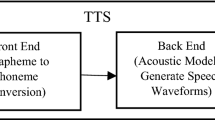Abstract
Prosody is the change of F0 and intensity in time and the speed of articulation. The presence or absence of the realization of word accent is also examined as an important feature in prosody generation. During verbal communication various prosody forms contribute to the expression of the textual content of the message on the one hand and of the personal intention of the speaker on the other. In many cases in dialogues the same text can be (must be) pronounced with different intentions. Our goal was to find what kind of prosody patterns and rules are characteristic of these utterance types and what the acoustic relationship among them is for Hungarian. In this article the prosody structures of the most important dialogue components are described, and invariant structures are derived and verified by speech synthesis. Rules are also stated as generalized function structures to show the acoustic relationship of the prosody of these expressions to the prosody of statements. Using these rules, it is possible to convert the prosody of a given utterance type to another one by preserving the naturalness of the speech. The rules can be used in text to speech (TTS) conversion to generate spoken dialogues.
Similar content being viewed by others
References
Adriaens, H. (1991). Ein modell deutscher Intonation. Ph.D. thesis, University of Leiden, The Netherlands.
Collier, R. (1990). Multi-lingual intonation synthesis: Principles and applications. In Proceedings of the ESCA Workshop on Speech Synthesis, Autrans, France, pp. 273–276.
Dirsken, A. and Quené, H. (1993). Prosodic analysis: The next generation. In V.J. van Heuven and L.C.W. Pols (Eds.), Analysis and Synthesis of Speech. Strategic Research towards High-quality text- to-speech Generation. New York, Mouton, De Grujter, pp. 131–144.
Fónagy, I. and Magdics, K. (1967). A magyar beszéd dallama. (The melody of Hungarian). Budapest, Akadémiai Kiadó.
Fujisaki, H. and Ohno, S. (1995). Analysis and modelling of fundamental frequency contours of English utterances. In Proceedings of the 4th European Conference on Speech Communication and Technology, Madrid, ESCA, pp. 985–988.
Gósy, M. (1992). Speech perception. Frankfurt am Main, Germany, Hector.
Montero, J.M., Gutiérrez-Arriola, J., Colás, J., Macias, J., Enriquez, E., and Pardo, J.M. (1999). Development of an emotional speech synthesiser in Spanish. In Proceedings of the 6th European Conference on Speech Communication and Technology, Budapest, ESCA, pp. 2099–2102.
Olaszy, G. (1989). Elektronikus beszédelőállítás. (Electronic speech generation), Budapest, Müszaki Kiadó.
Olaszy, G. (1991). A crosslinguistic description of intonation contours of a multilingual text-to-speech system. In Proceedings of the XIIth International Congresse of Phonetic Sciences. Aix-en-Provence, France, Universite de Provence, pp. 210–213.
Olaszy, G. and Németh, G. (1997). Prosody generation for German CTS/TTS systems (from theoretical intonation patterns to practical realisation). Speech Communication, 21:37–60.
O’Malley, M.H. and Peterson, J.E. (1966). An experimental method for prosodic analysis. Phonetica; 15:1–13.
Rank, E. and Pirker, H. (1998). Generating emotional speech with a concatenative synthesiser. In Proceedings of the International Congresse on Speech and Language Processing, Sydney, pp. 947–950.
Terken, J. and Collier, R. (1990). Designing algorithms for intonation in synthetic speech. In Proceedings of the ESCA Workshop on Speech Synthesis, Autrans, France, pp. 205–208.
Varga, L. (1993). A magyar beszéddallamok fonológiai, szemantikai és szintaktikai vonatkozásai. (Phonological and semantical points in Hungarian melody forms) Budapest, Nyelvtudományi Értekezések 135.
Author information
Authors and Affiliations
Rights and permissions
About this article
Cite this article
Olaszy, G. The Prosody Structure of Dialogue Components in Hungarian. International Journal of Speech Technology 3, 165–176 (2000). https://doi.org/10.1023/A:1026534229127
Issue Date:
DOI: https://doi.org/10.1023/A:1026534229127




